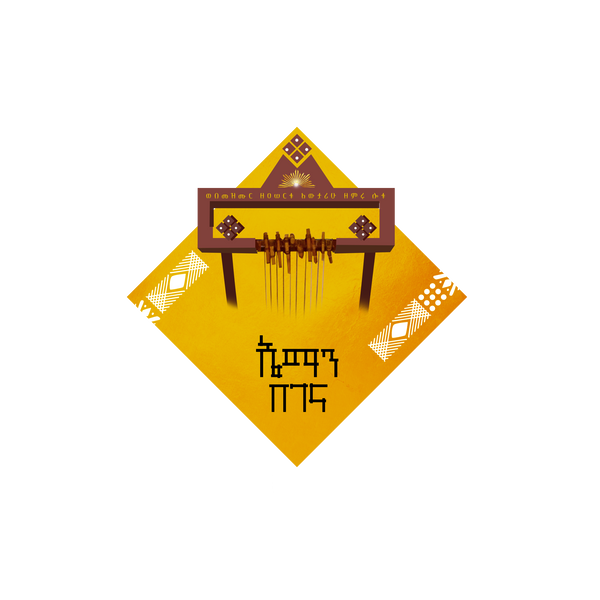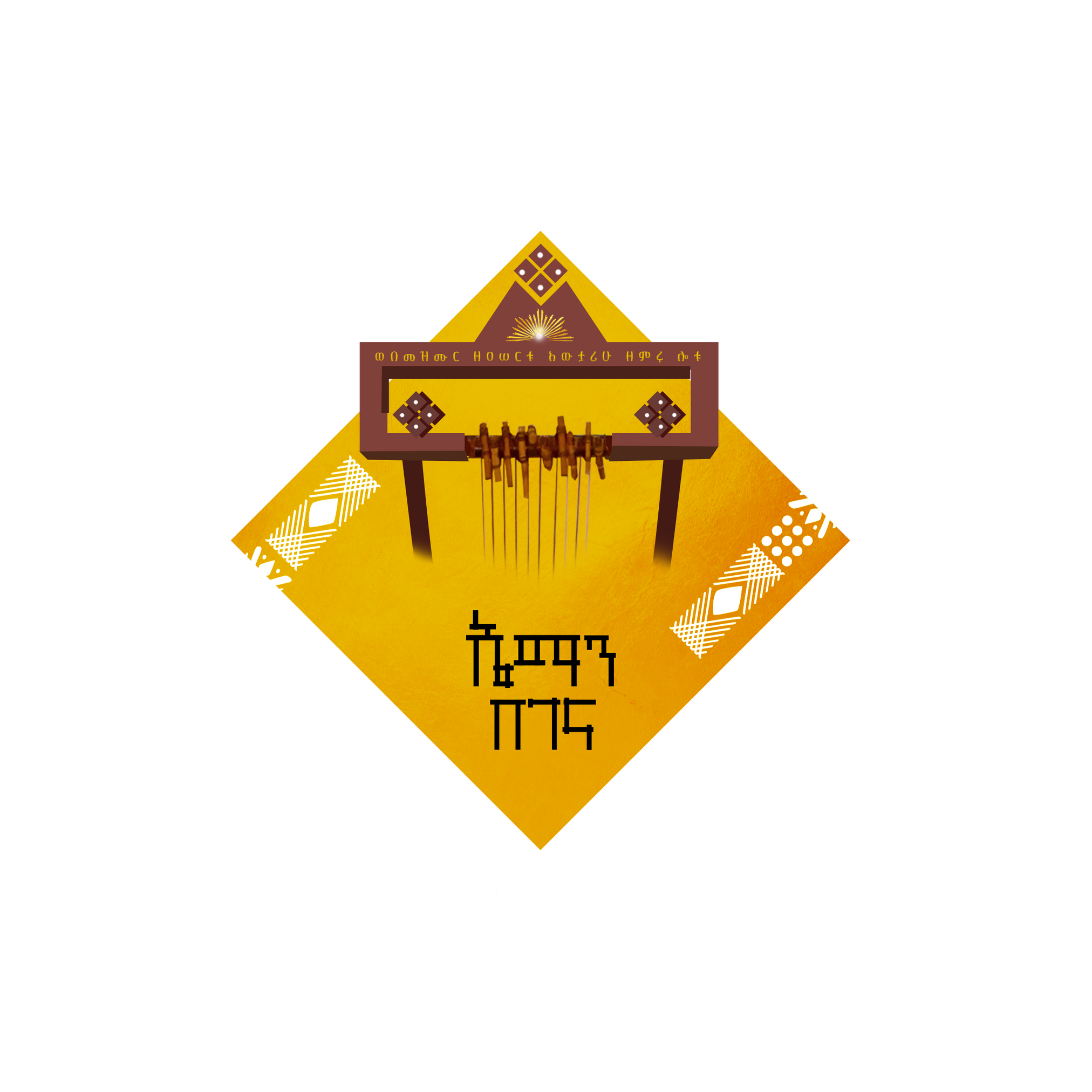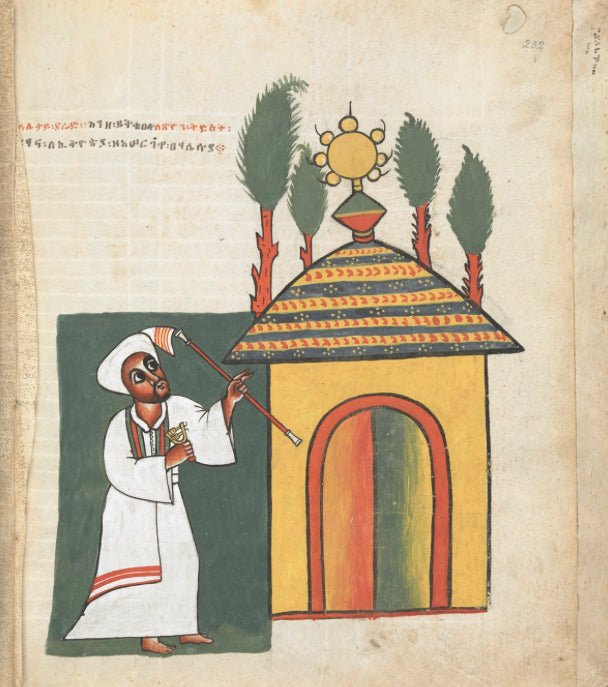Welcome to our weekly historical newsletter
Issue 1 of Understanding The History of Begena
All Things Saint Yared
Press Icon to listen to Songs in Saint Yared Melody (Yaredawi Zema)
To Understand or Learn about the Begena it is important to understand The Ethiopian Orthodox Tewahedo Church Musicology and it is imperative to know about Saint Yared and his teachings.
Saint Yared was a Music Composer in the 6th Century from the Axum empire of Ethiopia, His music and musical compositions are a central part of EOTC Praise, Worship and Liturgy.
Ethiopia is known to have the oldest music notes preserved fully in record thanks to him.
Saint Yared’s Musicology
I. Ge’ez:- The word Ge’ez comes from the language of Ge’ez which is believed to have the meaning “to be free”. In the music world Ge’ez means straight forward, proper scale or primary music scale. The Ge’ez melody is very strong and powerful thus often called raw melody.
II. Ezil:- Ezil translates to Second to Ge’ez another meaning is binding, firm or steadfast (This symbolizes Christ The Son of God who firmly withstood all the suffering to save Adam with his stead fast love): Thus Ezil means strong, and binding it is a secondary music type that binds with that of Ge’ez.
III. Araray:- Araray means one that is compassionate (This is one of the gifts the Holy Spirit bestowed on the Apostles), this music method refers to empathy and compassion.
The Teachings of Saint Yared explain to us that all creatures songs and melody falls into one of the three categories, thus these are the corner stones or the primary colors of all music.
Saint Yared Music Notes and their Symbols
I. Defat (Falling, Bowing) - A technique of chanting where the voice is suppressed and the neck is facing downward while inhaling air. (This symbolizes how God The Lord of Hosts came down from Heaven to save us).
II. Hidet (Continuity)- A chant that is used by stretching one’s voice like an endless flow. (This symbolizes how our Lord and Savior Jesus Christ, continually taught going from town to town and when he was caught went between Herod and the cross without saying anything.)
III. Kinat* (Straighten): The Last note of the chant that is sang by straightening your neck and holding your voice still
The word Kinat also means Jealousy, this note symbolizes how in jealousy Judas and the Jews toward Jesus and the events that followed.
IV. Yizet (Holding): Emphasizing (holding on to) one of the notes from a fast paced music. (This symbolizes how the Jews held Jesus Christ captive and also symbolizes how God has the world held in his hand).
V. Kurt* (Cut): A break from an extended chant by holding breathing and lowering voice as well as lowering the neck.
The word Kurt also means making up ones mind or holding on to a thought, this symbolizes that even though Christ suffered under the Jews judgement he did not waver because he had his mind made up to save Adam (Humankind).
VI. Chiret (scratch): This highlights other notes when they are louder or for a longer period of time. (This symbolizes all the scratches on our Lord Jesus Christ body when he got whipped by the Romans).
VII. Rikrik (Layered): Layering chants over a longer chant.
This symbolizes the blood of Christ that got layered while he got beaten.
VIII. Deret (chest)- A form of chant that comes from raising the chest and holding one note in a pinching manner (symbolizes our Lord’s ascension.)
Citation:
Live source: The EOTC Teachings, History and Culture of our Forfathers as told and taught
Zemedu, Girma. “Text-to-Hymn Synthesis for St Yared Hymn Notations.” (2014).

Table from Zemedu, Girma. “Text-to-Hymn Synthesis for St Yared Hymn Notations.” (2014).
የቅዱስ_ያሬድ_የዜማ_ስልቶች
፩.ግዕዝ፡- ግዕዝ የሚለው ቃል መሰረቱ የግዕዝ ቋንቋ ነው፡፡ ይኸውም ግዕዝ ተጓዘ ነፃ ወጣ ብሎ ግዕዝ ማለት ነፃ ማለት እንደሆነ የታመነ ነው።ይህ ትክክለኛ ትርጉም ሲሆን ግዕዝ የሚለው ቃል በዜማነቱ ሲተረጎም ደግሞ ርቱዕ(አብን ርቱዕ ሎቱ ናእኲቶ ለማለት) ወይም የቀና ቀጥተኛ፣አንደኛ ስልት፣መጀመሪያ ዜማ ማለት ነው በማለት ሊቃውንት ተርጉመውታል፡፡ ግዕዝ በዜማነቱ በጣም ጠንካራና ኃይለኛ ከመሆኑ የተነሣ ሊቃውንት ደረቅ ዜማ ይሉታል፡፡
፪.ዕዝል፡- ዕዝል ማለት የግዕዝ ድርብና ታዛይ፣ ሁለተኛ ማለት ሲሆን እንዲሁም ጽኑዕ(ወልድ ጽኑ መከራን ተቀብሎ አዳምን ለማዳኑ ምሳሌ)፣ ጠንካራ ማለት ነው ፡፡ በሌላ በኩል ደግሞ ዕዝል ማለት አዘለ አስተዛዘለ ከሚው የግዕዝ ወይም የግስ ቃል የተገኘ መሆኑ ይነገራል፡፡ ይህንንም መሰረት በማድረግ ሊቃውንቱ ዕዝል የሚለውን ቃል ከዜማው ጋር ያለውን ዝመድና ሲገልጹ ዕዝል ማለት ከግዕዝ ጋር ታዝሎ የመጣ ወይም የተገኘ ማለት ነው ይላሉ፡፡
፫.ዓራራይ፡-ዓራራይ ማለት ዓራኅራኂ፣ የሚያራራ፣ ጥዑም(ሃብተ መንፈስ ቅዱስ ለሐዋርያት የተሰጠ መሆኑን ለማጠየቅ) አሳዛኝ፣ልብን የሚመስጥ ማለት ነው፡፡
❖ በገድለ ያሬድም ላይ የሰውም ሆነ የእንስሳ የአራዊትም ሆነ የአዕዋፍ ዜማ ከሦስቱ የዜማ ምድቦች አይወጣም የሚል በመሆኑ ምንጊዜም የዜማ ሁሉ መሠረቶቹ እነርሱ ናቸው።
❖. ቤተ-ክርስቲያንን፣አባቶቻችንን፣ታሪካችንን፣ባህል፣
የቅዱስ_ያሬድ_የዜማ_ምልክቶች
፩.ድፋት = ድምጽንና አንገትን ወደ ታች ርግጥ አድርጎ ትንፋሽን ወደ ሆድ ዉስጥ በመመለስ ማዜም።
❖ምስጢሩ የክርስቶስን ከሰማየ ሰማያት መዉረድ ያስረዳል ።
፪.ሂደት = ሳታቆም ወይም ሳታቋርጥ ምንም ነገር ሳትይዝ ሰተት ብለህ ሂድ ወይም አዚም።
❖ምስጢሩ ጌታችን መድኃኒታችን ኢየሱስ ክርስቶስ በዚህ ዓለም እየተዘዋወረ ማስተማሩንና በከሰሱት ጊዜ ከሐና ወደ ቀያፋ ፤ ወደ ሄሮድስና ወደ ጲላጦስ ምንም ሳይናገር መመላለሱን ያስረዳል።
፫.ቅናት = በዜማዉ ቃል መጨረሻ ያለዉን አንዱን የፊደል ሆሄ ይዘህ አንገትህን በማቅናትና ድምጽህን እንቅ በማድረግ አዚም።
❖ምስጢሩ አይሁድ ጌታ ላይ መቅናታቸዉንና እየጮሁ አሳልፈዉ መስጠታቸዉን ያስረዳል ።
፬.ይዘት = በፍጥነት ከሚዜመዉ ዘር አንዱን የፊደል ሆሄ ያዝ በማድረግ አዚም።
❖ምስጢሩ አይሁድ ጌታን መያዛቸዉን እንዲሁም
እግዚአብሔሐር ዓለምን በመሀል እጁ የያዘ መሆኑን ያስረዳል።
፭.ቁርጥ = ድምጽን በመጠኑ በመቀነስ ፤ትንፋሽን ወደታች በማመቅና እንደገናም ድምጽን በማጋነንና አንገትን ወደ ፊት ገፋ በማድረግ አዚም።
❖ምስጢሩ አይሁድ ጌታን ቢያሰቃዩትም አዳምን
ለማዳን መቁረጡን ያስረዳል ።
፮.ጭረት = በዘር መካከል ያለዉን አንዱን ሆሄ ወደ ጎን ጫር በማድረግ አዚም።
❖ምስጢሩ የጌታችንን ግርፋት ያስረዳል።
፯.ርክርክ = ረጅም የሆነዉን ዜማ በላዩ ላይ ርክርክን በመጨመር በረጅሙ አዚም።
❖ምስጢሩ ጌታ በተገረፈ ጊዜ የተንጠባጠበዉን ደም ያስረዳል።
፰.ደረት = ደረትን ከፍ በማድረግና አንዱን የፊደል ሆሄ ወደ ላይ ቆንጠጥ በማድረግ አዚም።
❖ምስጢሩ የጌታን እርገት ያስረዳል።
#ከቅዱስ_ያሬድ_በኋላ_በተነሱ_ሊቃውንት_የተጨመሩ_የዜማ_ምልክቶች
፱.ድርስ /ስ/ =የቃል መጨረሻ የሆነዉን አንዱን የፊደል ሆሄ ወደ ላይ ቆንጦጥ በማድረግ ማዜም ማለት ነዉ ፡፡
❖ምስጢሩ የተነገረዉ ትንቢትና የተቆጠረዉ ሱባኤ በመድረሱ ተዋርዶና ተስፋ ቆርጦ የነበረዉን የሰዉ ልጅ የክርስቶስ መሥዋዕትነት ባስገኘለት ፍጹም ነጻነት ተስፋ ትንሳኤን ማግኘቱን የሚያመለክት ነዉ ፡፡
፲.አንብር ( ር ) =የአንዱን ዘር የመጨረሻ ሆሄ ያለምንም ተጨማሪ ድምጽና ርክርክ በማስቀመጥ ወይም በማቆም አዚም ማለት ነዉ፡፡
❖ምስጢሩ ጌታ የማዳን ሥራዉን ጨርሶ ወደ ሰማይ ካረገ በኋላ በአብ ቀኝ መቀመጡን ፤ አንድም ሰዎች በግራ የተመሰለ ግብረ ኃጥአትን ትተዉ በቀኝ የተመሰለን ግብረ ጽድቅ ብቻ በመሥራት ቢኖሩ በዕለተ ምጽዓት በቀኙ በኩል
የመቆማቸው ምሳሌ ነው።
❖ቤተ-ክርስቲያንን፣አባቶቻችንን፣ታሪካችንን፣ባህል፣



